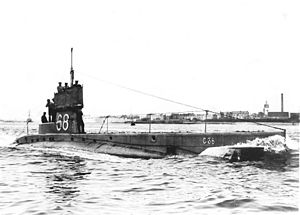HMS C11
 From Wikipedia the free encyclopedia
From Wikipedia the free encyclopedia
 HMS C38 – a typical C-class submarine | |
| History | |
|---|---|
| Name | HMS C11 |
| Builder | Vickers, Barrow |
| Laid down | 6 April 1906 |
| Launched | 27 March 1907 |
| Commissioned | 3 September 1907 |
| Fate | Sunk in collision 14 July 1909 |
| General characteristics | |
| Class and type | C-class submarine |
| Displacement |
|
| Length | 142 ft 3 in (43.4 m) |
| Beam | 13 ft 7 in (4.1 m) |
| Draught | 11 ft 6 in (3.5 m) |
| Installed power |
|
| Propulsion |
|
| Speed |
|
| Range | 910 nmi (1,690 km; 1,050 mi) at 12 kn (22 km/h; 14 mph) on the surface |
| Test depth | 100 feet (30.5 m) |
| Complement | 2 officers and 14 ratings |
| Armament | 2 × 18 in (450 mm) bow torpedo tubes |
HMS C11 was one of 38 C-class submarines built for the Royal Navy in the first decade of the 20th century. The boat was lost after being rammed in 1909.
Design and description[edit]
The C class was essentially a repeat of the preceding B class, albeit with better performance underwater. The submarine had a length of 142 feet 3 inches (43.4 m) overall, a beam of 13 feet 7 inches (4.1 m) and a mean draft of 11 feet 6 inches (3.5 m). They displaced 287 long tons (292 t) on the surface and 316 long tons (321 t) submerged. The C-class submarines had a crew of two officers and fourteen ratings.[1]
For surface running, the boats were powered by a single 16-cylinder 600-brake-horsepower (447 kW) Vickers petrol engine that drove one propeller shaft. When submerged the propeller was driven by a 300-horsepower (224 kW) electric motor.[1] They could reach 12 knots (22 km/h; 14 mph) on the surface and 7 knots (13 km/h; 8.1 mph) underwater. On the surface, the C class had a range of 910 nautical miles (1,690 km; 1,050 mi) at 12 knots (22 km/h; 14 mph).[2]
The boats were armed with two 18-inch (45 cm) torpedo tubes in the bow. They could carry a pair of reload torpedoes, but generally did not as they would have to remove an equal weight of fuel in compensation.[3]
Construction and career[edit]
C11 was built by Vickers at their Barrow-in-Furness shipyard, laid down on 6 April 1906 and was commissioned on 3 September 1907. The boat was sunk in a collision with the collier Eddystone in the North Sea south of Cromer, Norfolk on 14 July 1909.[4] There were only three survivors.[4] Attempts were made to salvage the stricken submarine but they were abandoned in September 1909, after only a single body had been recovered.[5] The wreck was rediscovered in the late 1990s.
Notes[edit]
- ^ a b Gardiner & Gray, p. 87
- ^ Harrison, Chapter 3
- ^ Harrison, Chapter 27
- ^ a b Gray, Edwyn (2003). Disasters of the Deep A Comprehensive Survey of Submarine Accidents & Disasters. Leo Cooper. p. 64. ISBN 0-85052-987-5.
- ^ "Naval Matters—Past and Prospective: Sheerness Dockyard". The Marine Engineer and Naval Architect. Vol. 32. October 1909. p. 98.
References[edit]
- Akermann, Paul (2002). Encyclopaedia of British Submarines 1901–1955 (reprint of the 1989 ed.). Penzance, Cornwall: Periscope Publishing. ISBN 1-904381-05-7.
- Colledge, J. J.; Warlow, Ben (2006) [1969]. Ships of the Royal Navy: The Complete Record of all Fighting Ships of the Royal Navy (Rev. ed.). London: Chatham Publishing. ISBN 978-1-86176-281-8.
- Gardiner, Robert & Gray, Randal, eds. (1985). Conway's All the World's Fighting Ships 1906–1921. Annapolis, Maryland: Naval Institute Press. ISBN 0-85177-245-5.
- Harrison, A. N. (January 1979). "The Development of HM Submarines From Holland No. 1 (1901) to Porpoise (1930) (BR3043)". RN Subs. Retrieved 27 September 2022.
External links[edit]
- HMS C11 Roll of Honour
- 'Submarine losses 1904 to present day' – Royal Navy Submarine Museum Archived 7 January 2018 at the Wayback Machine